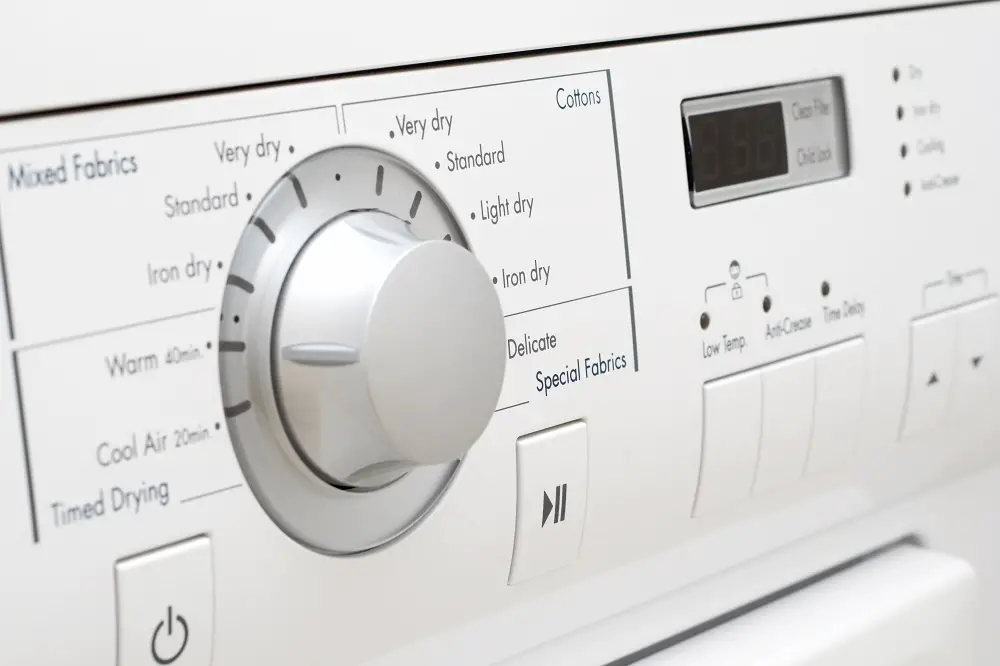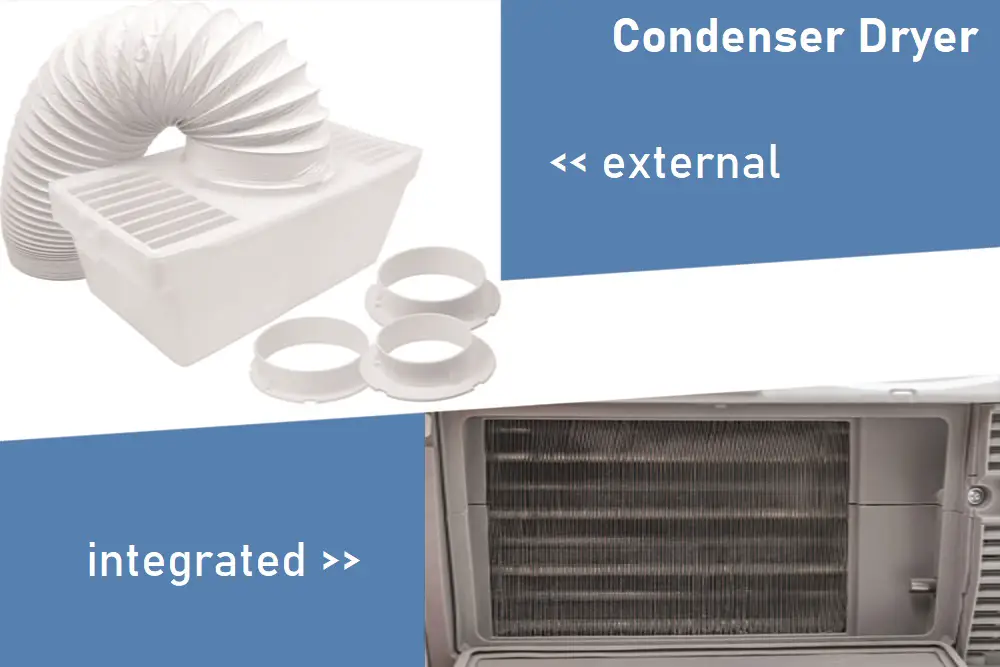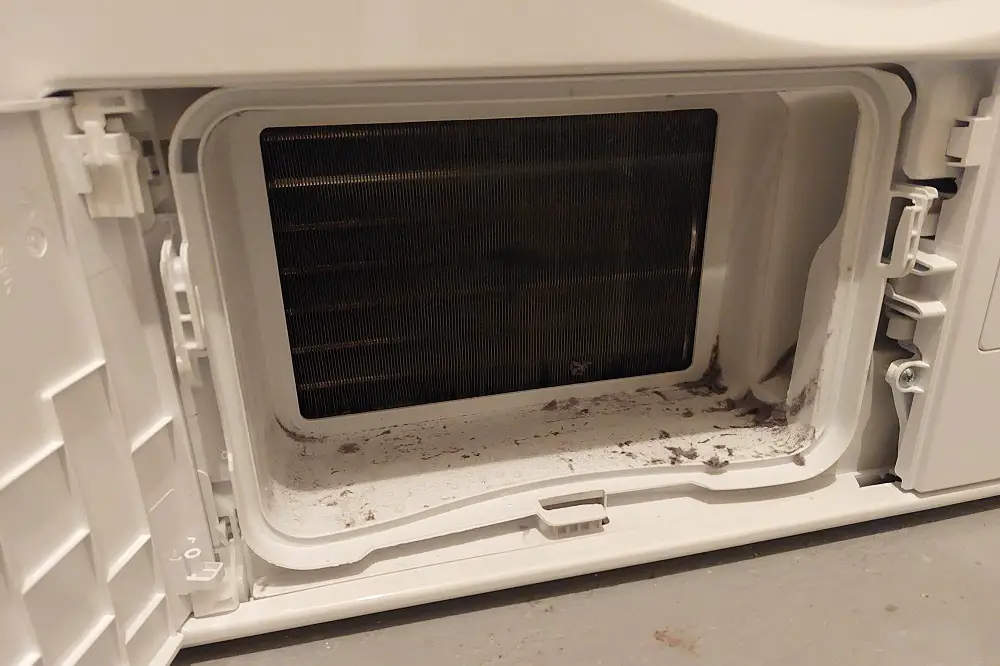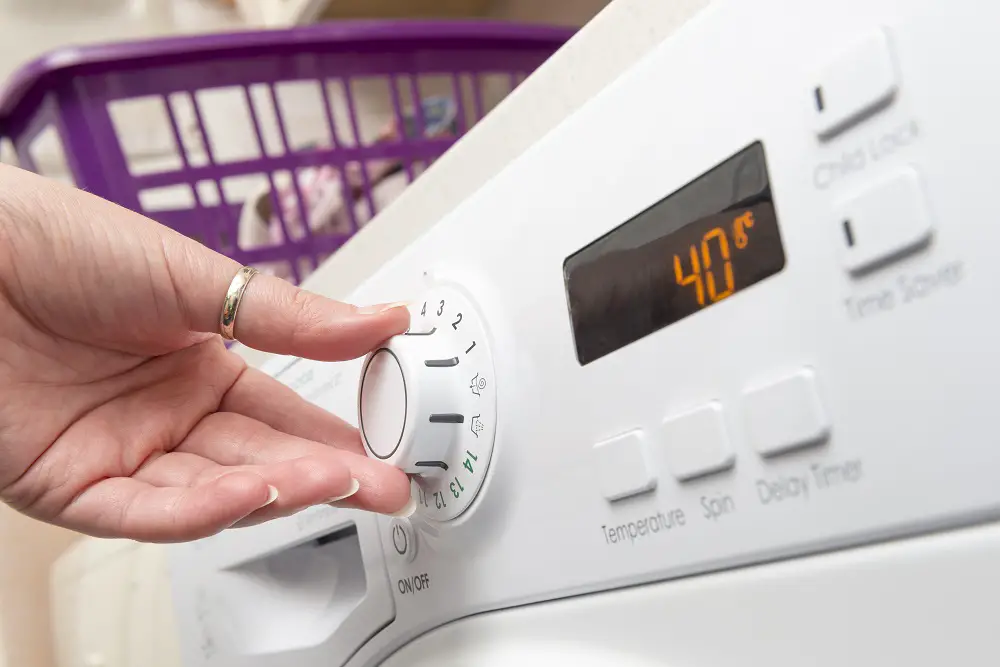The tumble dry setting of a dryer is a convenient and faster alternative to air drying or line drying.
If your dress care label has the tumble dry symbol – a square with a large circle inscribed – it means it can go in the dryer. The more small black dots inside the circle, the higher the heat required to dry the garment.

Delicate clothing or fabrics that require gentle drying must be dried using the tumble dry low setting. If your dryer doesn’t have the tumble dry low setting, there are some alternative drying techniques instead.
Table of Contents
What is Tumble Dry Low?
Tumble dry low is when your laundry tumbles in the dryer drum on a low heat setting. While this may take more drying time for your laundry, it’s the safest option for delicates or gentle fabrics.
Low heat setting is used for delicate clothing like lingerie, knitwear, winter coats, loosely woven fabrics, and sportswear (made of lycra or spandex). Similarly, it would be best if you dried anything with iron-on decals and embellishments like sequins or beading in tumble dry low.
Delicate fabrics are often heat-sensitive, and tumble dry low helps preserve such fabrics from warping, stretching, wrinkling, fading, or fraying.
Common Tumble Dry Settings
Most drying machines that have tumble drying have the following options:
- No heat (air dry)
- Normal
- Low heat setting
- Medium heat setting
- High heat (heavy duty)
- Quick dry
With the common temperature range of most dryers being 125°F (55°C) – 145°F (75°C), the different tumble dry settings are:
| Setting | Temp | Laundry Symbols | Garments |
|---|---|---|---|
| Low | Within 125°F (55°C) | Wool, lingerie, sportswear, nylon, embellished fabrics, delicate items | |
| Medium | Within 135°F (65°C) | Regular t-shirts, shirts, and trousers | |
| High | Within 145°F (75°C) | Heavy items like towels and jeans |
Each brand has its own philosophy on how to name the specific cycles and it isn’t easy all the time to know which mode refers to which temperature.

If you don’t have an appliance that uses the temperature as a reference, you’ll need to check the manual for the appropriate heat setting.
9 Tumble Dry Low Alternatives
If your machine doesn’t have the tumble dry low setting, here are some other useful alternatives to get your clothes dry:
- Repeat the spin-dry cycle in your washing machine to wring out excess water before air drying or tumble drying.
- Use the lower heat options of the dryer to avoid damaging delicate fabrics.
- Use a dehumidifier to dry your laundry.
It uses lesser energy than a tumble dryer and causes no fabric damage. - Hang dry outdoors or use a drying rack with sufficient indoor ventilation.
Set your drying rack or hang the clothes close to a sunny window, furnace, radiator, or fireplace to speed up the drying. - Use the delicate or gentle setting if your dryer has it.
- Use a handheld hairdryer.
With the wrung-out clothes laying flat, you can use the hairdryer with warm or hot air to dry each clothing item spot-by-spot. - Roll your clothes in a towel individually and twist each portion of the towel bit by bit.
- Use the iron and towel technique.
Place a clean, dry towel over the garment on an ironing board and iron the towel on both sides using high heat. - Use the air dry or air fluff setting of your dryer machine – a no-heat option.
Why New Dryers Should Have Tumble Dry Low
Opting to completely dry your laundry using tumble dry settings makes for great convenience. However, you can’t use the tumble dry high setting for drying clothes quicker all the time.
A lot of clothes these days have sensitive fabrics and are delicate. To machine dry such items, you must use a low heat level such as the tumble dry low. Some fabrics that need to be tumble dried in low heat include
- Acrylic (scarves, gloves, sweaters, and tracksuits): It will permanently wrinkle if a high temperature is used.
- 100% cotton clothes: Shrinks with high heat.
- Denim: Must be dried with low heat and a delicate cycle to keep their shape for longer.
- Microfiber (cycling jerseys, upholstery, mats, knitwear, and cleaning dusters) items: They dry quickly.
- Nylon items: They dry quickly, and a low-temperature cycle will suffice.
- Polyester blends: They’re also quick drying.
- Spandex (compression wear, swimsuits, and sporting attire)
- Silk blends
- Woolen blends
With dryers being regularly used, it’s an advantage to have the tumble dry low setting for the following reasons:
- Reducing heat saves more dryer energy than reducing the tumbling
- Helps save money on electricity bill
- Reduces the risk of dryer fires
- Reduces wear and tear to clothes, especially expensive ones; clothes will last longer
Is Tumble Dry No Heat The Same As Tumble Dry Low?
Tumble dry no heat and tumble dry low are two different settings. The tumble dry no heat option runs the dryer with zero heat. Your dryer might have an ‘air-only’ option instead of tumble-drying with no heat.
It simply tumbles your clothes in the dryer drum and uses room-temperature air instead of heat.

If your garment care label has a square with a large black circle, it must be tumble dried with no heat.
This setting is used for very delicate items that can’t withstand heat and are often used to fluff up garments and help remove lint, dust, and hair between washes. It takes longer to dry clothes than tumble dry with heat, although not as long as line drying.
On the other hand, tumble dry low uses the lower heat setting of the dryer (typically around 125 degrees Fahrenheit).
Is Air Fluff The Same As Tumble Dry Low?
Air fluff or air dry is not the same as tumble dry low. The air fluff setting produces no heat (while tumble dry low uses low heat). In this setting, the dryer pulls air from the surroundings and dries the laundry using this room-temperature air.
If your machine doesn’t have a tumble dry low setting but has the air dry or air fluff feature, it’s a good alternative. It’s a safe option for materials that can’t tolerate heat due to the possibility of melting, damage, or shrinkage.
Is Delicate The Same As Tumble Dry Low?
Tumble dry low is almost the same as a delicate or gentle cycle. Both use a lower heat setting to avoid damage to the fabrics. However, a delicate cycle is often gentler than other cycles. Generally, tumble dry low and delicate settings are safe to use if you want to keep your clothes in good condition in a tumble dryer.
Machines may have one, both, or neither of these settings. If your machine doesn’t have either of these settings, opt for a low-temperature setting or a ‘synthetic’ option.
Conclusion
Several garments require the tumble dry low setting to avoid wear and tear. So, always refer to the care label of each item of clothing to decide the right way of washing or drying them.
If your machine doesn’t have the tumble dry low option, there are alternative ways of drying your laundry. Tumble dry low, with lower heat, may be time-consuming, but it’s a safer way to dry clothes.



